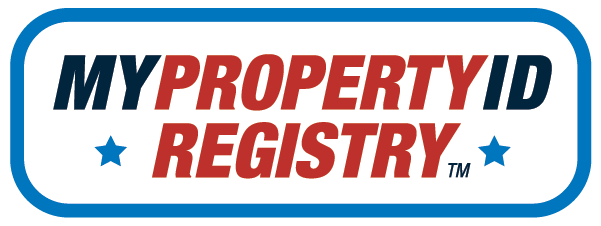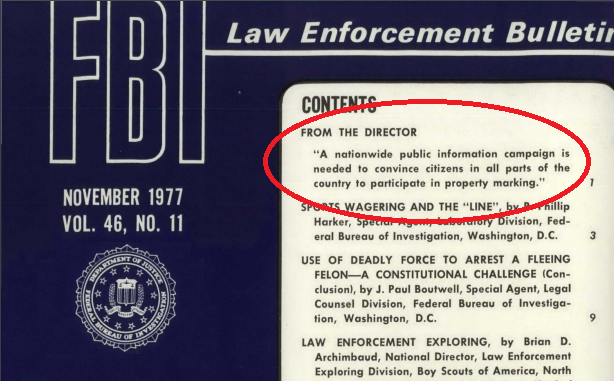NOTE: The following text is a duplicate of an article appearing in the FBI Law Enforcement Bulletin. November 1977, on the top of the contents page, and pages 1 and 2. In its transcription, there may be minor errors. The goal of posting this article is to allow search engines a cleaner version to scrape.
FBI Law Enforcement Bulletin – November 1977
Clarence M. Kelley, FBI Director. In office between July 9, 1973, and February 15, 1978.
Clarence M. Kelley – Wikipedia
FROM THE DIRECTOR:
“A nationwide public information campaign is needed to convince citizens in all parts of the country to participate in property marking.”
“THE FOLLOWING IS A JOINT STATEMENT of the National Law Enforcement Committee on Operation Identification, which I wholeheartedly support. ”
The identification and return of stolen property has been a major problem facing law enforcement agencies for decades. In response to this problem, two national organizations representing nearly all of the State, county, and municipal law enforcement administrators-the National Sheriffs’ Association (NSA) and the International Association of Chiefs of Police (IACP)- have recently established a committee composed of representatives of the national law enforcement community to find a solution. Representatives of the Federal Bureau of Investigation, the National Crime Prevention Institute, and the National Conference of State Criminal Justice Planning Administrators met at the invitation of Ferris E. Lucas, Executive Director of NSA, and Glen D. King, Executive Director of the IACP, on July 20, 1977, at the J. Edgar Hoover F.RI. Building in Washington, D.C.
The committee members determined that law enforcement agencies throughout the United States recover millions of stolen items as the result of criminal investigations and arrests. However, many of the recovered items bear no identifiable markings or serial numbers which could be used to locate or identify the rightful owners. Moreover, in those instances where an item has been serialized by its manufacturer, the average citizen fails to maintain a record of that number.
In 1963, a program was developed to facilitate the identification, recovery, and return of stolen property. This program, commonly known as “Operation Identification,” encouraged citizens to mark valuable items with a unique personal identifier so that each item would become more readily identifiable and traceable to its rightful owner in the event of its loss or theft. A number of citizen groups and law enforcement agencies have established Operation Identification programs since that time. However, all of the programs have failed to achieve complete success as the result of one or more of the following shortcomings: (1) Lack of uniformity in the assignment of owner identification numbers; (2) failure to coordinate program activities with other jurisdictions; (3) lack of planning, coordination, or administration of program activities; (4) failure to enlist a significant number of citizen participants in the program; and (5) failure by local law enforcement agencies to utilize Operation Identification as an investigative technique rather than solely as a public relations program.
Recognizing the enormity of the problem of identifying and recovering stolen property, FBI Director Clarence M. Kelley urged the criminal justice administrators who serve on the Advisory Policy Board of the National Crime Information Center (NCIC) to improve the center’s capability to facilitate the identification of the owners of stolen property. NCIC is a national computerized information system operated and managed by the FBI, which enables Federal, State, county, and municipal law enforcement agencies to share information with regard to stolen property, wanted or missing persons, and criminal histories. As a result of Mr. Kelley’s recommendation, the NCIC Policy Advisory Board recommended that the NCIC files concerning stolen articles be expanded to include an “Owner Applied Number” along with a full description of the stolen article. Since September 19, 1977, law enforcement agencies have been able to enter and index any stolen property in the NCIC Article File which is marked with a unique owner applied number, if that number is reported to the police.
To fully achieve the benefits of the new NCIC capabilities, a nationwide effort to encourage both law enforcement agencies and private citizens to participate in an OwnerApplied Number (OAN) or Operation Identification program is needed, as well as the establishment of a recognized uniform numbering system which will assist in identifying the owner of the property.
The purpose of the newly organized National Law Enforcement Committee for Operation Identification is to promote the involvement of law enforcement agencies in property marking programs as a strategy for discouraging the theft of personal property and a useful technique in criminal] investigation.
Without the support and participation of the law enforcement community, such a program cannot succeed. With such support, official and citizen cooperative program can increase greatly the number of stolen item identified and recovered each year. A nationwide public information campaign is needed to convince citizen in all part of the country to participate in property marking. The support of service clubs, labor organizations, civic group, and private business must be enlisted to conduct door-to-door campaigns to assist owners in marking their property in an appropriate manner.
In addition, law enforcement officer must be trained to record owner-applied number as a part of their descriptions of property stolen in official reports, and they mu t be able to recognize owner-applied number when they recover articles.
Properly administered, and utilizing a nationally accepted uniform numbering system, Operation Identification can assist police administrators in identifying stolen property that has found its way into the legitimate market, returning stolen property to its rightful owner, and gathering direct physical evidence to assist in prosecution of criminal violations involving property theft.
Committee chairperson Ferris E. Lucas reported that the committee in its initial session had identified the following objectives:
- To develop a uniform owner numbering system that will identify an owner regardless of where he lives or how many times he moves;
- To prepare and disseminate guidelines for establishing and maintaining successful official-citizen property marking programs;
- To encourage State and local law enforcement agencies to adopt property marking programs as a crime reduction and criminal investigation technique involving the total law enforcement agency;
- To provide guidelines for the development of law training programs in property marking and identification;
- To provide and disseminate to law enforcement agencies a property identification manual that will provide guidelines for establishing local property marking programs, describe the procedures required in law enforcement agencies to establish the program as an investigative technique, and describe what articles would be marked and how and where to mark them; and
- To encourage manufacturer to mark valuable merchandise and equipment with serial numbers at the time of manufacture, and to encourage retail dealers to assist buyers in marking items purchased with an owner-applied number at the time of sale.
As it proceeds with it assignment, the committee expects to solicit suggestions and advice from law enforcement administrator, business, industry, and citizen groups and will be working closely with the National Crime Information Center and its Advisory Policy Board.



